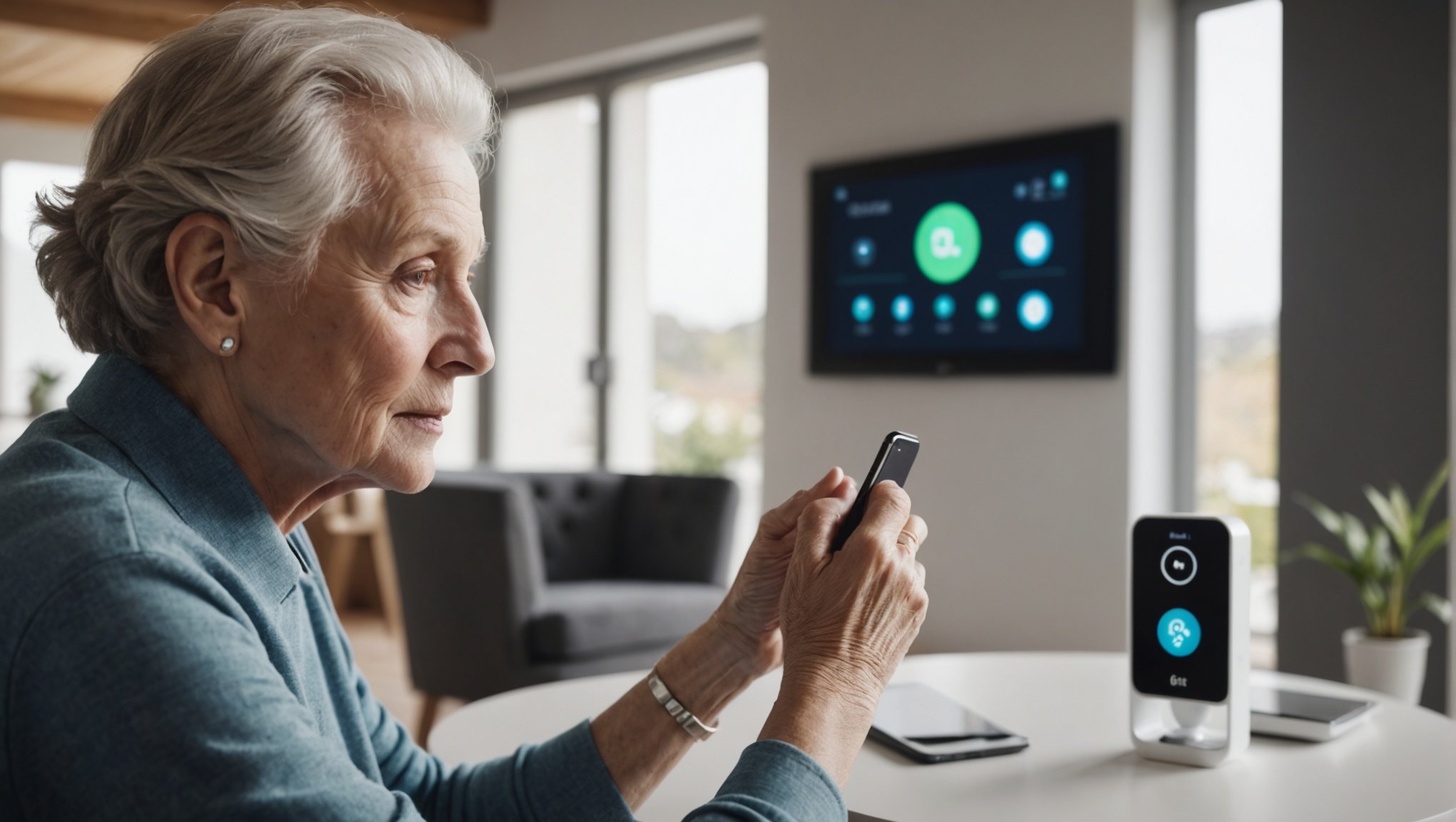Smart home technology can transform lives, especially for seniors. Tailoring these innovations to meet the unique needs of older adults fosters independence and comfort. This approach goes beyond convenience; it empowers them to engage with their environment effortlessly. Explore the essential features and thoughtful solutions that can make a smart home genuinely user-friendly and enriching for seniors. Discover how simple adjustments can enhance their daily routines and ensure they feel confident with technology.
Understanding the Needs of Senior Users
Exploring technology with empathy and clarity
In parallel : Elevate Your Minimalist Home: Crafting a Stylish Multi-Level Indoor Plant Display
Identifying the common challenges faced by seniors using technology is essential for developing solutions that cater to their needs. Many seniors encounter difficulties with complex interfaces and small text, which can hinder their ability to fully utilize smart home systems. Accessibility features, such as voice commands and larger icons, are crucial in making technology more approachable.
Importance of Accessibility Features
Smart home accessibility is a key consideration when designing technology for senior users. Features like automated lighting, voice-activated assistants, and emergency alerts can significantly enhance quality of life. These features not only provide convenience but also ensure safety and independence for seniors.
Also read : Explore Sustainable Strategies for Effective Mosquito Management in Your Garden
Role of User-Friendly Interfaces
The adoption of smart home systems by seniors is greatly influenced by the presence of user-friendly technology. Simplified interfaces with intuitive navigation can encourage seniors to embrace new technologies confidently.
- Common Challenges:
- Complex interfaces
- Small text and icons
- Limited tech support
Incorporating these elements into design can transform the way seniors interact with technology, making it an integral and positive part of their daily lives. By addressing these needs, we can foster a more inclusive technological environment for all users.
Essential Smart Home Technologies for Seniors
Enhancing daily life through innovation and simplicity
Overview of Essential Smart Home Devices
Smart home devices are transforming the way seniors interact with their living spaces. Senior-friendly technology is designed to simplify and enhance daily routines. Key devices include smart speakers and displays, which offer voice-activated controls and visual aids. These tools are invaluable for seniors who may find traditional interfaces challenging.
Recommended User-Friendly Smart Speakers and Displays
Smart speakers like Amazon Echo or Google Nest provide intuitive voice commands, making them ideal for seniors. These devices can manage daily reminders, answer questions, and control other smart home features. Displays with large screens offer visual assistance, improving accessibility further.
Importance of Smart Lighting and Temperature Control
Smart lighting and temperature control systems are crucial in maintaining comfort and safety. Automated lighting ensures well-lit spaces, reducing fall risks. Meanwhile, smart thermostats adjust temperatures to optimal levels, enhancing energy efficiency and comfort.
- Benefits:
- Voice-activated controls
- Visual assistance
- Energy efficiency
Incorporating these technologies into senior homes not only promotes independence but also ensures a safer, more comfortable living environment. By embracing home automation, seniors can enjoy a more connected and convenient lifestyle.
Designing an Accessible Smart Home Environment
Optimizing spaces for comfort and technology integration
Key Principles of Accessible Home Design
Creating a home design for seniors involves a thoughtful approach to accessibility and ergonomic tech. Prioritize open spaces to allow easy movement and ensure that smart devices are within reach and easy to use. Consider installing smart home features that can be controlled via voice or large, simple interfaces, reducing the need for physical interaction.
Integrating Technology into Existing Layouts
Adapting existing layouts to include accessibility in smart homes can be achieved with strategic planning. Identify areas where technology can enhance daily living, such as automated lighting in hallways or voice-activated assistants in common areas. This approach ensures that technology complements the current environment without requiring extensive renovations.
- Integration Tips:
- Position devices at accessible heights
- Use wireless systems to minimize clutter
- Select tech with intuitive design
Importance of Ergonomic Design
The role of ergonomic tech is crucial in ensuring that seniors can use smart home devices comfortably. Choose products with adjustable features and user-friendly interfaces. This not only enhances usability but also encourages consistent use, contributing to a more connected lifestyle.
By focusing on these principles, seniors can enjoy a seamless blend of comfort and innovation in their homes.
Safety Features in Smart Home Technologies
Ensuring security and peace of mind through innovation
Overview of Safety Features
Smart home safety is a crucial aspect of modern living, particularly for seniors. These technologies offer various features designed to enhance security and comfort. Monitoring systems for seniors can include motion detectors, door sensors, and cameras that provide real-time updates. Such systems ensure that seniors are safe and that family members can check in remotely.
Importance of Monitoring Systems
The role of monitoring systems for seniors extends beyond convenience. They are vital for fall detection and emergency response, providing immediate alerts to caregivers or emergency services. This capability can be a lifesaver, offering peace of mind to both seniors and their families.
- Key Features:
- Motion detectors
- Fall detection
- Emergency alerts
Recommendations for Smart Home Security Systems
When considering smart home safety, it's essential to choose systems tailored for seniors. Look for user-friendly interfaces and reliable alert systems. Products like smart locks and video doorbells can enhance security without complicating daily routines. Emergency response features should be easy to activate, ensuring prompt assistance when needed.
By integrating these safety features, seniors can maintain their independence while ensuring a secure living environment, thus embracing the full benefits of smart home technology.
Implementing Voice-Controlled Technology
Exploring the benefits and setup of smart home voice control
Benefits of Voice-Controlled Devices for Seniors
Voice-activated devices offer significant advantages for seniors, providing a hands-free way to interact with technology. These devices simplify everyday tasks, from setting reminders to controlling home environments, enhancing independence and convenience. Smart home voice control allows seniors to manage lighting, temperature, and entertainment systems effortlessly, reducing the need for physical interaction.
Recommended Voice Assistants and Compatible Devices
Choosing the right voice assistants is crucial for optimizing a smart home. Popular options include Amazon Alexa, Google Assistant, and Apple's Siri, each offering unique features tailored to senior needs. Compatible devices, such as smart speakers and displays, integrate seamlessly with these assistants, providing a comprehensive hands-free technology experience.
- Top Voice Assistants:
- Amazon Alexa
- Google Assistant
- Apple Siri
How to Set Up and Optimize Voice Control for Ease of Use
Setting up smart home voice control involves connecting devices to a central hub and customizing settings for individual preferences. Ensure that devices are within hearing range and that voice commands are straightforward. Regular updates and training can further enhance the functionality of voice-activated devices, making them more responsive and user-friendly for seniors.
Enhancing Daily Living with Smart Home Solutions
Simplifying routines through innovation
Examples of Daily Tasks Made Easier
Smart home solutions significantly enhance daily living aids by simplifying routine tasks. For instance, automated lighting systems can adjust brightness based on the time of day, ensuring optimal visibility without manual intervention. Voice-activated assistants help seniors set reminders, control appliances, and even order groceries, promoting a seamless lifestyle.
- Daily Living Aids:
- Automated lighting
- Voice commands for reminders
- Smart appliance control
Promoting Independence in Seniors
Smart home devices are pivotal in fostering independence in seniors. By offering hands-free control over various home functions, these technologies reduce reliance on others. Smart thermostats and security systems provide both comfort and safety, allowing seniors to live independently with confidence. This empowerment leads to an enhanced quality of life and greater self-sufficiency.
Testimonials from Successful Users
Many seniors testify to the transformative impact of smart home assistance. One user noted, "My smart speaker has become an invaluable companion, reminding me of my medication schedule and even playing my favorite tunes." Such testimonials highlight the profound lifestyle enhancement achieved through these technologies, illustrating their practical benefits and emotional support.
Step-by-Step Guide to Setting Up a Smart Home
Transforming your home with ease and efficiency
Planning Your Smart Home Setup
Embarking on a smart home setup requires careful planning. Start by evaluating your home's layout and identifying areas where technology can enhance daily living. Consider the specific needs of seniors, such as voice-activated controls and user-friendly interfaces. Document your goals and prioritize devices that align with these objectives.
Selecting and Purchasing Devices
Choosing the right devices is crucial for a successful technology implementation. Focus on products that offer simplicity and accessibility. Look for features like automated lighting and smart speakers with intuitive design. When purchasing, compare options to ensure compatibility with existing systems and check for senior-friendly features.
- Device Selection Tips:
- Prioritize ease of use
- Ensure compatibility with current tech
- Look for senior-friendly features
Installation and Troubleshooting
Once your devices are selected, follow a systematic approach to installation. Begin with the central hub, often a smart speaker or display, to connect all devices. For troubleshooting, consult the device manual or online resources. Common issues like connectivity problems can often be resolved by resetting the network or updating software.
By following these steps, seniors can enjoy a seamless and efficient smart home setup, enhancing their quality of life through technology.
Real-Life Examples of Successful Smart Home Implementations
Exploring transformative senior tech success stories
Case Studies of Smart Home Adaptations
Examining smart home case studies offers insightful perspectives into how technology transforms senior living. One notable example is the Smith family, who integrated voice-activated controls and automated lighting for their elderly father. This adaptation not only improved his independence but also reduced fall risks, showcasing the practical benefits of smart home implementations.
User Testimonials and Family Experiences
Hearing directly from users provides valuable insights into the impact of senior tech success stories. Mrs. Johnson, a 78-year-old, shared, “The smart thermostat has made managing my home’s temperature effortless.” Her son added that the system’s simplicity eased his concerns about her comfort and safety, highlighting the positive influence of smart home case studies.
Lessons from Real-Life Experiences
Real-life smart home experiences reveal crucial lessons. For instance, involving seniors in the setup process enhances their comfort with the technology. Additionally, selecting devices with intuitive interfaces is critical. These case studies underscore the importance of tailoring technology to individual needs, reinforcing the potential for senior tech success stories to improve quality of life.
- Key Learnings:
- Involvement in setup increases comfort
- Intuitive interfaces are essential
- Tailored solutions enhance effectiveness
These examples demonstrate the transformative power of smart home implementations in fostering independence and safety for seniors.
Resources for Further Learning and Support
Empowering seniors and caregivers with essential knowledge
Online Resources for Smart Home Technologies
Discovering smart home resources can greatly enhance understanding and implementation of technology for seniors. Websites like TechBoomers and Senior Planet offer comprehensive tutorials and guides tailored for older adults. These platforms provide step-by-step instructions, ensuring that seniors can confidently navigate their smart home devices.
Support Organizations and Communities
Numerous senior tech support organizations are dedicated to assisting older adults in embracing technology. The AARP and Silver Surfers are notable for their community-based support and educational workshops. These groups foster an environment where seniors can share experiences and learn from one another, promoting a supportive learning culture.
Recommended Reading and Guides for Caregivers
Caregivers play a crucial role in facilitating technology adoption for seniors. Educational materials such as "Smart Homes for Seniors" by Lisa Cini provide invaluable insights into effectively integrating technology into daily life. These resources offer practical advice and strategies, empowering caregivers to better support their loved ones.
- Key Resources:
- TechBoomers tutorials
- Senior Planet guides
- AARP workshops
- "Smart Homes for Seniors" book
By utilizing these resources, both seniors and caregivers can stay informed and confident in their ability to leverage smart home technologies effectively.











